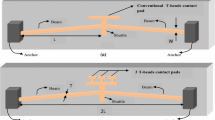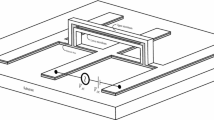Abstract
Fixed-fixed beams are ubiquitous MEMS structures that are integral components for sensors and actuation mechanisms. However, residual stress inherent in surface micromachining can affect the mechanical behavior of fixed-fixed structures, and even can cause buckling. A self-tensioning support post design that utilizes the compressive residual stress of trapped sacrificial oxide to control the stress state passively and locally in a fixed-fixed beam is proposed and detailed. The thickness and length of the trapped oxide affects the amount of stress in the beam. With this design, compression can be reduced or even converted into tension. An analytical model and a 3D finite element model are presented. The analytical model shows relatively good agreement with a 3D finite element model, indicating that it can be used for design purposes. A series of fixed-fixed beams were fabricated to demonstrate that the tensioning support post causes a reduction in buckling amplitude, even pulling the beam into tension. Phase shifting interferometry deflection measurements were used to confirm the trends observed from the models. Controlling residual stress allows longer fixed-fixed beams to be fabricated without buckling, which can improve the performance range of sensors. This technique can also enable local stress control, which is important for sensors.
Similar content being viewed by others
References
G. B. Hocker, D. Youngner, M. Butler, M. Sinclair, T. Plowman, E. Deutsch, A. Volpicelli, S. Senturia, and A. J. Ricco, “The Polychromator: a programmable MEMS diffraction grating for synthetic spectra,” Proc. Solid-State Sensor and Actuator Workshop, Hilton Head, SC, June 4–8, 2000.
M. A. Huff, A. D. Nikolich, and M. A. Schmidt, “A threshold pressure switch utilizing plastic deformation of silicon,” International Conference Solid-State Sensor and Actuators, 1991, pp. 177–180.
D. S. Popescu, D. C. Dascalu, M. Elwenspoek, and T. Lammerink, “Silicon active microvalves using buckled membranes for actuation,” International Conference Solid-State Sensors and Actuators, Stockholm, Sweden, June 25–29, 1995, pp. 305–308.
C. L. Goldsmith, Z. Yao, S. Eshelman, and D. Denniston, “Performance of low-loss RF MEMS capacitive switches,” IEEE Microwave and Guided Wave Letters, Vol. 8, No. 8, August 1998, pp. 269–271.
C.d. Liao, and J.C. Tsai, “The evolution of MEMS displays,” IEEE Trans. On Industrial Electronics, Vol. 56., No. 4, April 2009, pp. 1057–1065.
E. Iwase, P.C. Hui, D. Woolf, A. W. Rodriguez, S. G. Johnson, F. Capasso, and M. Loncar, “Control of buckling in large micromembranes using engineered support structures,” J. Micromech. Microeng. 22(6), 2012.
P. A. Hassanpour, P. M. Nieva, and A. Khajepour, “A passive mechanism for thermal stress regulation in micro-machined beam-type structures,” Microsyst. Technol., Vol 18., No. 5, 2012, pp. 543–556.
S. M. Sze, VLSI Technology. New York: McGraw-Hill, 1983.
N.D. Masters, M. P. de Boer, B.D. Jensen, M.S. Baker, and D. Koester, “Side-by-side comparison of passive mems strain test structures under residual compression,” ASTM STP 1413, 2001, pp. 168–200.
B. D. Jensen, M. P. de Boer, and S. L. Miller, “IMAP: Interferometry for material property measurement in MEMS,” MSM’ 99, vol., San Juan, Puerto Rico, 1999, pp. 206–209.
Acknowledgments
Research supported by Sandia National Laboratories (SNL) and Carnegie Mellon University (CMU) through the SNL/CMU Excellence in Engineering Research Program and partially supported by Sandia National Laboratories through Award No. 1270979. One of the authors (RMP) was also supported by the Neil and Jo Bushnell Fellowship in Engineering.
Author information
Authors and Affiliations
Rights and permissions
About this article
Cite this article
Pocratsky, R.M., de Boer, M.P. Self-tensioning Support Post Design to Control Residual Stress in MEMS Fixed-Fixed Beams. MRS Online Proceedings Library 1659, 55–61 (2014). https://doi.org/10.1557/opl.2014.99
Published:
Issue Date:
DOI: https://doi.org/10.1557/opl.2014.99




